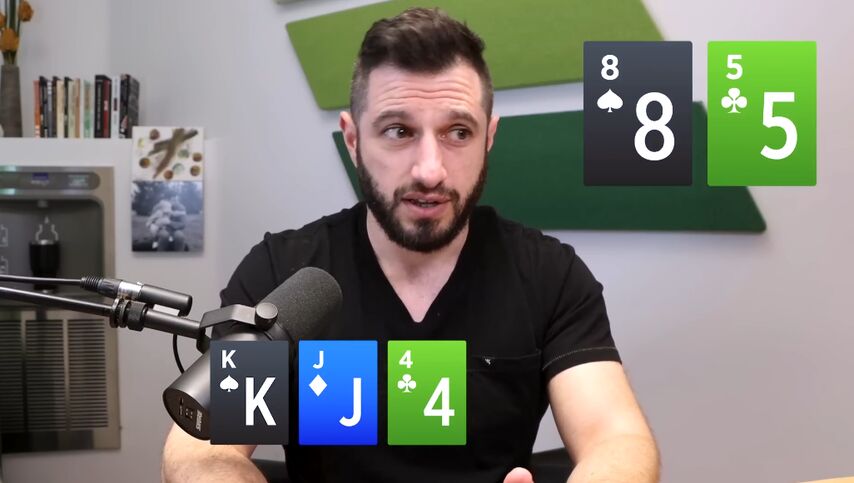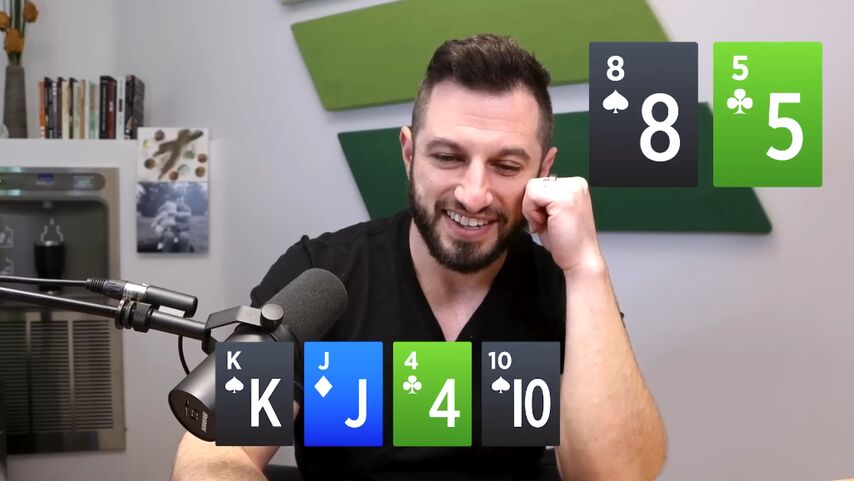In recent years, a lot has changed in my strategy under the influence of solvers. After all, when I started playing poker 15 years ago, there was no such software. When solvers came along, they greatly improved our understanding of how poker works. Turns out we didn't know much about the game. In this video, I will try to highlight the five main shortcomings of my strategy, which I got rid of relatively recently. I'll start from the end.
5. Frequent c-bets on the flop
In Hold'em, Omaha, single-raised pots, and after 3-bets, I've c-bet too much. There was a period in hold'em when it was enough to raise and c-bet 90% of the time. In Omaha, this worked worse, but there you could first 3-bet, and then a c-bet on 90% of flops printed money. It was a terrible strategy, and I figured out what was wrong with it even before the solvers, but the solvers convincingly confirmed my conclusions. There are boards where you can c-bet with your whole range, but on other textures it is correct to play a 100% check. We must learn to distinguish one from the other.
4. 3-betting with a too polar range
I used to 3-bet for value with aces, kings, queens, and other strong hands in hold'em a long time ago, and 3-bet bluffs with 85s, T4s, etc. And outside of these ranges there were hands that I did not play – T7s, for example, or J8s. With A4s I called, not 3bet. However, this approach to choosing hands to 3-bet turned out to be wrong.
When faced with a raise, we first need to decide if our hand is good enough to at least call to continue, and then we can build a 3-betting range based on selected hands. In many cases, we benefit from a linear 3-betting/4-betting strategy where we swap with the top of the range and a complex set of weaker hands to cover textures. Sometimes you really need to be very polar. This happens when we have a calling range. For example, we're defending the big blind against an open from middle position – we call fairly wide and 3-bet more polar. Although there are situations when a linear 3-bet strategy is more profitable.

Let's move on to the third point:
3. Raise with hands not strong enough to call
I really liked this approach. In some situations, it works. However, in most cases, as solvers show, if a hand is not strong enough to call, it is not good enough to raise. Perhaps this is more true in Omaha than in Hold'em, although I think that is often the case in Hold'em as well.
When thinking about raising, I've had this philosophy for a very long time: I know the hands I want to raise with for value, and I'll pick bluffs from hands I'd otherwise have to fold. Now I use this approach quite rarely.
2. Frequent use of small sizings
It's funny that 15 years ago, especially in tournaments, all the regulars were making tiny continuation bets and betting small on the turn. Then for a while it went out of fashion, everyone started mixing checks and big bets. Solvers have taught us that sizing depends only on texture, and generalizing is bad. There are boards where it is good to bet a little with the whole range, and there are boards where it is correct to play only with large sizes. A key role in the choice is given to the texture and, of course, the interaction of the ranges of the players.
Small bets are a very important part of poker strategy, especially out of position. However, 10 years ago, they meant one of two things: not wanting to bloat the pot – we block to prevent our opponent from betting more, or an attempt to provoke a raise when we have a monster. Now we know that such a strategy has much more nuance. For example, with it, we take advantage of the fact that a certain part of our range is stronger than a similar part of our opponent's range. If you make a big bet, the advantage will disappear, since the opponent has enough hands to protect against large bets, but against a small bet he will be forced to defend too wide, and this will cause him serious inconvenience. By splitting one big bet into two small bets, we extract additional value.
The last point, in my opinion, is rather curious.
1. Game "by dynamics"
You can call it a metagame, but a metagame is something global, and a dynamic game relies on the momentary and the transient. Let's say I haven't c-bet the turn for a long time, so now my opponent has to believe if me I bet two barrels!

In fact, such a game model should not be completely written off as scrap even now, but when you play with people who work a lot on theory, the dynamics practically do not matter. And I spend most of my time fighting regulars who want to play as close to GTO as possible. In our matches, situations periodically arise that are similar to the game in terms of dynamics, as if the opponents are adjusting to us on the fly, but this is almost always due to the fact that they were simply dealt the right cards. Therefore, I for the most part stopped following the dynamics, interpreting it and trying to use it to my advantage.
No, of course, it happens that when an opponent calls a big bet and a big check-raise on the river in a row, and is wrong both times, he gets very upset and suspects that he is being outplayed. In this state, he is unlikely to want to make a difficult hand or make another expensive call so as not to feel stupid again. Or if his big bluff has just been opened, you can not wait for another bluff in the next hands, because he risks not only money, but also new negative emotions. Nobody wants to look stupid.
Although all this is very individual and depends on the individual player.
I want to tell a story where dynamic play and raising with hands that can't call are intertwined. Perhaps this is the most memorable hand in my life, so I talked about it more than once. I played heads-up for a bracelet in a $25,000 6-max World Series event and didn't raise the flop for a very long time. At some point, I got tired of it, and I decided to reraise with full air. I don't remember the board exactly, but I'll give you an approximate one so that you understand the essence.
 With this hand, I check-raised dynamically.
With this hand, I check-raised dynamically.The opponent called. The turn came a ten, covering many draws. Now he should definitely believe me, I thought, and bet half pot. If he called, the pot on the river would be my stack. Our stacks were about equal, maybe I have a little more, maybe he has.
However, he didn't call, he min-raised!

I can't call out of position with 8-high. There are two options left – all-in or fold. But I couldn't believe that he would raise a strong hand! This is crazy, because on my line I'm clearly going to bet all-in on the river! Why would he stop my bluffs? I was young then, I had an aggressive image of a player from the Internet. My opponent was Steve Sang, also a young guy with some online success, but who grew up playing live poker. Strong player. That's why I couldn't believe that he would raise me on the turn instead of letting me bluff further.
I thought for a very long time. With 8-high, no outs. Never before in my life have I shoved the turn with a hand that had 0% equity when called. At least a flush draw! At least a gutshot! And here I am sitting in the heads-up of a World Series tournament and thinking about it seriously.
I didn't dare to go all-in. An important factor was how idiotic my decision would look if Steve shrugged and called. I imagined this pain and decided that I did not need it. Fold.
Then on the stream I saw that he had a weak top pair. He decided to raise-fold because he didn't want to pay a big bet on the river. If I went all-in, I would have 80% of the chips.
Heads-up I lost. This is my only second place in World Series tournaments.
If I could go back in time, I wouldn't check-raise the flop in the first place, but if I got to the turn, I would go all the way, trusting my gut. It seems that I did not include the adoption of intuitive decisions in this list. Let it be bonus point number zero: over the years, thanks to the accumulated experience and the backdrop of a relatively successful playing career, I have learned to trust my poker instincts. Many times I have done complete madness at the table and turned out to be right. And although sometimes lose, I'm still in the black in such situations. So if I trust my gut on the next hand and don't guess, I won't beat myself up and call it a mistake. I will say to myself: “Well, it’s necessary! When I have such a strong feeling, I usually turn out to be right. Just bad luck. Okay, let's play on!"
